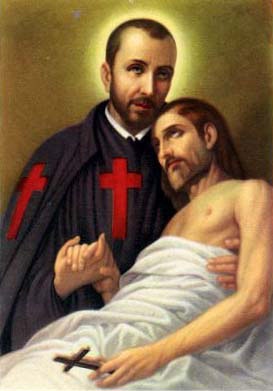Camillian Cross
Brothers in the Order of Camillians wear a red cross on their cassocks; a symbol which has become ubiquitous in identifying doctors and other health carers, hospitals, medical supplies, and of course the international Red Cross.
Camillus (or Camillo) de Lellis was born on May 25, 1550, in Bucchianico in the Abruzzo region of Italy. His birth is remarkable in that he was a strong and healthy boy, even though his mother, Camilla Compelli de Laureto, was almost 60 years old when he was born.
Soon after his birth, Camilla had a dream that showed her son with an ominous red cross on his chest, leading other men bearing similar crosses. She interpreted this to mean her son was destined to lead a gang of criminals to the gallows. She died when Camillus was 13, with a much troubled spirit. She could not have imagined that Camillus would establish a religious congregation and eventually become patron saint of hospitals, hospital workers and nurses.
His upbringing was left to his father, Giovanni, who had been a captain in the Neapolitan and French armies. With no mother to raise him, it is no surprise that Camillus followed his father's military career path, stationed first in Venice and then in Naples. Surrounded by other wild young men, Camillus developed a compulsion for cards and dice. It was not long before he lost all his money and his health failed, including crippling abscesses in both feet. He was then of little use to the army and became destitute.
He took charity from the Franciscan monastery of the Capuchins in Manfredonia and repaid their kindness by doing maintenance work in the monastery. In 1575, Camillus experienced a spiritual conversion and dedicated his life to the service of God.
But joining a congregation is not simple, as you can see on the Order of Camillians website camillians.org (or at least, not as easy as our spoof in How To Become A Monk). And for Camillus, despite his rugged strength, his festering crippled feet prevented him from being accepted into the community.
So he moved to Rome and began working at St. James's Hospital for Incurables. Sadly, whilst the abscesses on his legs might have been brought under control, his vice for gambling and wild disposition was not tamed. He was dismissed from the hospital and joined the Venetian army to fight the Turks in 1569.
When the fighting was over, he went back to work at the monastery at Manfredonia where a friar convinced him that being a professional killer was not what Jesus meant when he said "Love thy neighbour as thyself". He was admitted to the order as a lay brother but his infirmity prevented him from carrying out his duties. So once more, he went to St. James's Hospital in the centre of Rome, both for treatment and to help in nursing the other patients.

People often have a phobia about sick people. Quite understandable, really. So who but a saint would hold a sick person in this way? You can see the peace in the man's eyes.
In time, his dedication to the sick and dying earned him promotion and at the age of 32, became head of the hospital. Whilst working there, he embarked on the study of Latin at a Jesuit college and in 1584 was ordained.
He established an order of similarly dedicated men called 'Fathers of a Good Death', and chose for them a distinctive red cross to wear on their black cassocks. Their vocation was to care for those afflicted by the plague, even though they put themselves in mortal danger by doing so.
Two brothers became martyrs after contracting the plague whilst tending victims quarantined on a boat moored in Naples harbour. This was very different to the dream his mother Camilla had had of cross-bearing criminals being led to the gallows.
Despite the risk to his own health, and the continuing impediment to his mobility, Camillus continued caring for the sick. He also established many houses in other parts of the country.
In 1591, Pope Gregorio XIV made the congregation a religious order, the Ordine dei Ministri degli Infermi. Camillus died on 14 July 1614 and over 100 years later was beatified (1742). Four years after that he was canonized by Benedict XIV, calling him the 'Founder of a new school of charity'.
Camillus thus became patron saint of hospitals, hospital workers and nurses.
The Order of Camillians is still going strong (in 33 countries), still focus their attention on caring for the sick, and still bear the red cross. It's possible that Camillus' life influenced the Geneva Convention's decision to adopt the Red Cross emblem.
See also Red Cross
Yet more trivia... Cappuccio means 'hood' in Italian and the Franciscan friars customarily wore a hood to protect them from the harsh mountain weather. One way to keep a cup of coffee warm is to cap it with a layer of frothy cream. Hence the term 'Cappuccino'.
Ospedale San Giacomo (St. James Hospital) was one of the oldest hospitals in Europe and closed 2008 after 680 years service.
"Love thy neighbour as thyself" Matt. 22:36-40
